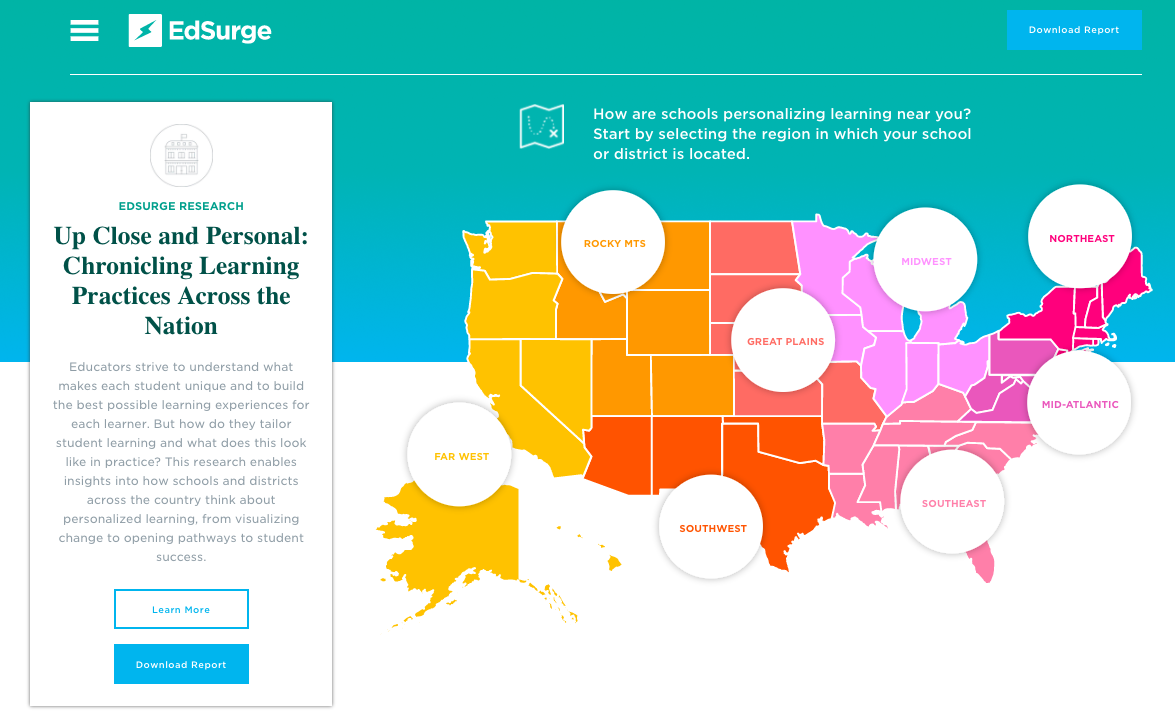What’s in a name?
At EdSurge, we’re researchers and journalists, not philosophers. But after a year-long, data-driven, deep dive into how people understand and apply the learning approaches variously called personalized learning, individualized instruction and differentiation, we’re intimately familiar with Shakespeare’s conundrum.
Educators have long worked to tailor learning experiences to students’ unique goals, needs and abilities. In this effort, they’ve shared a single hopeful objective: to find ways for education to grow in equity and impact. But, at a granular level, how people define personalized learning varies, and how they implement it does, too.
EdSurge has chronicled the evolution of personalized learning for several years, and one thing we’ve learned is that there’s wide variation in how educators define the term and what it looks like in practice. In October 2016, we started taking a closer look at the issues surrounding nomenclature and meaning and how that impacts implementation. Our research was designed to dig into four guiding questions:
- What characterizes a personalized learning student experience?
- Which instructional and structural strategies do schools and districts use to support personalized learning?
- Which technologies do schools and districts use to support personalized learning?
- Which challenges do schools and districts face when transitioning to personalized learning environments?
With support from the Bill & Melinda Gates Foundation, we worked with a team of industry experts to create a tagging schema—a codebook for addressing our central questions and discovering trends around how educators tailor learning experiences for each student.
Mining for Meaning
We designed the codebook to help us analyze texts and surface patterns and trends across different schools and districts. This is crucial because historically, research around personalized learning has tended to focus on the tactics of a limited number of schools that adopt highly innovative learning models tailored to their specific student communities. We believe that sharing evidence of how a wider net of schools envision and implement personalized learning can give peer schools insights that can move their practices forward.
So, what is a tagging schema exactly—and what does it take to build one? It is a set of keywords or phrases grouped into concept categories called tags, each describing a distinct aspect of the topic at hand—in this case, personalized learning. These tags are then used by trained “coders” to mine a set of texts and apply appropriate tags to surface patterns and trends.
SNAPSHOT: What Is a Tagging Schema?
| What It Is | What It Isn’t |
| A set of keywords and phrases (also known as tags) that describes the phenomenon of interest—personalized learning | A definition of personalized learning, or a framework for implementing personalized learning |
| Flexible—researchers and practitioners can add and remove keywords and phrases as personalized learning models become outdated or new models emerge | Fixed—a static set of keywords and phrases that do not evolve as personalized learning models become outdated or new models emerge |
| A combination of industry frameworks | A focus on one framework over another |
Building and refining a tagging schema takes time. It took our team three months and five iterations to build a solid version that we could use to begin text analysis. Our codebook is flexible; new tags can be added and old ones removed as practices evolve. We plan to continuously evaluate and update the codebook based on feedback from the edtech field. If you have an interest in shaping the tagging schema, please reach out to research@edsurge.com.
Cracking the Code
We coded a collection of over 300 texts from three existing EdSurge sources: 50 articles authored by educators across the country, 125 artifacts from interviews we've conducted with edtech administrators about their school needs, and 125 profiles of schools and districts we’ve researched and created over the past few years. As a result, we found four key trends—each addressing one of our research questions.
Based on our research, it was evident that most practitioners consider student-directed learning to be a key component of personalized learning. To build a student-driven learning environment, many educators believe that elevating student voice and giving learners a variety of ways to exercise choice in how they learn is critical. These choices can include everything from deciding on a project topic and establishing how to demonstrate proficiency, to setting their own pace and reflecting on their progress. Empowering students to make decisions encourages them to feel confident, respected and valued.
Our research analysis revealed that blended learning was the most common instructional model amongst the schools and districts in our dataset. These blended environments include classrooms with a one-to-one device-to-student ratio, classrooms with shared computers and rotation schedules and classrooms that follow a flipped learning model. Most of these schools and districts were shifting a portion of student learning online and investing heavily in laptops and edtech tools. A caveat, however, is that our dataset is comprised of schools and districts with technology-rich environments, which is not necessarily indicative of all schools across the country.
Educators and administrators collect a lot of data. By tracking student progress and competency they can pinpoint where students can, or cannot, apply concepts and skills and when to step in to provide feedback and support. Our research demonstrated that data management tools are crucial to supporting personalization and employing a common data exchange process helps create an environment where data can be shared across systems and tools so that practitioners can make informed decisions for their students.
Changing classroom strategy to tailor instruction to student needs takes time, resources and support from school leaders. Based on our research, professional development programs are key to overcoming implementation challenges. They can deepen educators’ awareness of how students learn, how to make the classroom inclusive, how to incorporate digital tools into learning, and how to use data to inform interventions for students. Much like students, teachers have unique needs and require programs designed to meet their individual needs as well.
Celebrating These Practices
Our initial goal with this work was to uncover trends and patterns related to how the term personalized learning is being interpreted—and to better understand how those interpretations impact implementations of personalized learning models in schools and districts across the country. We also wanted to share evidence of teaching and learning practices aimed at addressing the unique needs of each student.
In order to make change on the ground, educators and school leaders need to see examples of how their peers are making learning personal, how they’re tackling challenges, and what successes they are celebrating.
We’ve developed a website to give schools and districts a glimpse into how their peers are working to translate a vision of personalized learning into practice. We hope that educators and school leaders will use this site to find stories that resonate and that they will explore ways to help students thrive.



